1 Hour Solar Production - 1 Hour Energy Consumption
=
Amount of kWh that will get an NBC attached to them. Like a leech.
See You on the bright side!
You know when you go into an article on the internet and it gives you some information, but you still feel like something is missing?
Well, this is NOT one of those. This is solar in California like never explained before. We'll talk about 3 things:
#1. The California net metering war & the final window of opportunity.
#2. Net metering 2.0: The key to understanding how solar really works in CA.
#3. Net metering 3.0: Doomsday for solar in California is arriving on 2022.
NO fluffy information, NO abstract concepts and NO shallow explanations.
Enjoy.

Back in 1995, it all started when senate bill SB 656 was passed. Although it had things like a cap on the system size and vague laws, it did lay the groundwork for what would become a nationwide movement.
Since then, many states have followed suit by implementing similar policies, but as of today, some of those have also backtracked. And sadly, California is about to become one of them.
Why?
From the moment this started, there has been an ongoing war between the solar advocates (inside & outside the government) and the energy monopolies. Or monopoly? That's a subject for another day.
They've been doing everything they can to put a stop to the solar uprising, just like in Terminator®.
And it just so happens that Arnold Schwarzenegger was the one who kickstarted that uprising in 2009 when he signed senate bill AB 920 and gave birth to a new era; that of the Net Metering.
The legal framework in it made California one of the best states for solar. It stated that every kWh produced by a renewable source would have to be credited at the current market value or 100% of its value.
Example: Let's pretend that back then, any given utility was selling the kWh at ¢15. That means that every kWh produced by solar would get credited at ¢15 as well. A 1:1 rate.
And why would you need to get "credited"? What does a 1:1 rate do?
To answer that, let's zone in on something that will help you better understand it before we keep moving forward...
Have you ever wondered how do you get your energy at night when the sun is not feeding your solar panels? That's where net metering comes into play.
During the day, there are hours where your panels will produce more than what you can use in that precise moment and hours where they just won't produce. Take a look at this graph:
Image taken from our friends at NorcalSolar.org
As you can see, the sun starts coming up and with it your production, then around noon peak production is achieved, and from there it starts to ramp back down.
The thing is, at hours of peak production, you're probably only going to be using around 40% of the energy available at that moment, and that excess has to go somewhere...
Well, it goes into the grid.
💭 Think of net metering as a bank that stores your excess energy on the grid, while you're waiting for the hours without sunlight to arrive.
But what if we were to look at it from a week's perspective or even a whole year instead of a 1-day window?
The same thing would happen.
During the year there are seasons and months where you'll consume more than what your system generates (typically summer), and others that work the other way around.
At the end of the year, they balance each other out.
Take a look at this 1-year graph. The light-blue line is the solar production and the blue bars are the consumption for that month:
Can you see how the year's worth of electricity generated by your system, equates to 100% of what your house would use during that same year? (Assuming that your system was properly designed of course.
Now that you know the excess energy goes into the grid, you might already smell where I'm going with this...
What do you think would happen if it didn't get credited at 100% or a 1:1 rate? Let's think of an arbitrary value here, and say that instead it got credited at 75% of its value or -1 to 0.75-, like in Nevada.
Example: Imagine that in March, your system generated an extra 500 kWh that you didn't use. If the energy company sells the kilowatt at ¢30, that would be 150 bucks worth of energy (500kWh x $0.30 = $150).
But instead of storing those $150, they would only store 75% of that which would be 112 bucks ($150 x 0.75% = $112).
Can you see why Schwarzenegger deserved an Oscar for his performance when he secured a 1:1 rate for homeowners with solar in 2009?
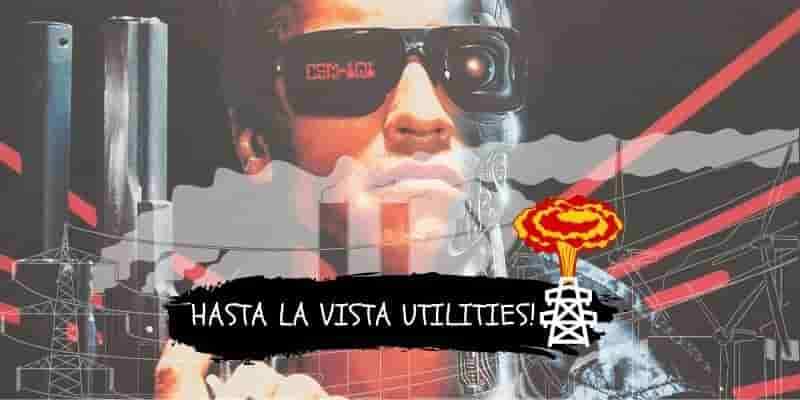
Utilities were officially Terminated with the Net Metering Bill. Their high commands and executives probably puked when they heard of it.
It is no secret that they don't like what solar can bring onto them. Even during the 90s, when the groundwork was barely set, they made sure to manifest that discomfort.
But this time it was worse. Thanks to that framework, solar started growing uncontrollably. And that poked the bear.
States started looking up to California. Everyone was happy. Except for them of course. And they were not going to let their huge profits evaporate in the blink of an eye...
They knew Net Metering was designed to be revisited once the total solar installations for each utility (PG&E, SCE, and SDG&E) reached 5% of the total peak electricity demand.
So it was only a matter of waiting for that to happen...
Fast forward, in 2016, their opportunity came and they made their move by arguing that solar owners were still using their precious, and most importantly, privately-owned grid for their benefit, and to them, that was unfair.
They said that people with solar were not paying their fair share for things like grid maintenance and electricity delivery and that due to that, they were forced to raise the prices for people without it. Because somebody had to pay for it.
But wait... Were we not already paying for that grid usage with the Minimum Delivery Charges? (I'm also going to explain those below in case you don't feel like reading another whole blog post.) 👍
Absolutely yes!
But the good guys at the CPUC looked into this and found that it was partially true. After validating these claims, they issued a new version for the Net Metering that addressed that, and they called it Net Metering 2.0.
(CPUC is short for California Public Utilities Commission. They're the ones in charge of overseeing 20 or so proposals from different entities and coming up with a final Net Metering framework that works for all parties.)
🔑 This one's the key to understanding how solar really works in California.
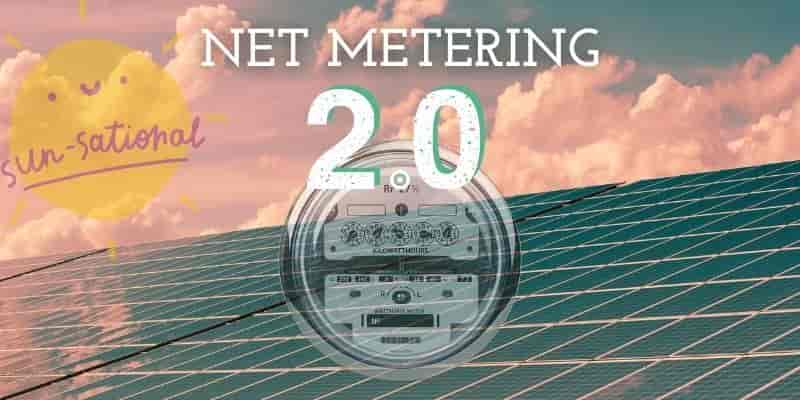
Ok, so it's 2016 and Net Metering 2.0 is up and running. Utilities were heard and more importantly, they were pleased.
5 policies were implemented to tackle the "free" grid usage and the shifting of costs towards non-solar households.
In short, now you have to pay more to account for that, you'll see why:
This is a one-time fee that has to be paid after your system passed the city inspection so it can be turned on.
PG&E: $145
SDG&E: $132
SCE: $75
This was not that bad of a change since it's only a one-time thing. Plus the majority of solar companies pay this for their customers so it's nothing you have to worry about.
This had already been instated for previous versions of the Net Metering but was kept for Version 2.0.
These Minimum Delivery Charges are supposed to cover the minimum costs of electricity delivery and its 24-hours availability.
It's a fee of about ¢33 per day plus a tiny amount of tax. To approximate the monthly cost you have to multiply that by the number of days in a month.
To be more precise, as of 2021, these fees are:
PG&E: ¢33 cents per day.
SDG&E: ¢33 cents per day.
SCE: ¢35 cents per day.

Example: Let's think of SCE. There are 31 days in October. So 31 x $0.35 = $10.85. Plus tax, it will end up in the $12s.
💭 This is the ONLY thing that has to be paid on a monthly basis aside from your solar payment.
NSCR's stand for Net Surplus Compensation Rates.
You know how you're able to carry over the excess energy you produce from hour to hour, day to day, week to week, and month to month?
Well, if at the end of a 12 months period you have excess energy, you will still be able to carry it over for the next year. However, it's going to be at a much lower rate than its original value.
This was instated because utilities were saying that it was like if they were buying that excess energy at a much higher price compared to the one they get it at. And once again, they were making non-solar users pay for the difference.
And how much less is it going to be worth?
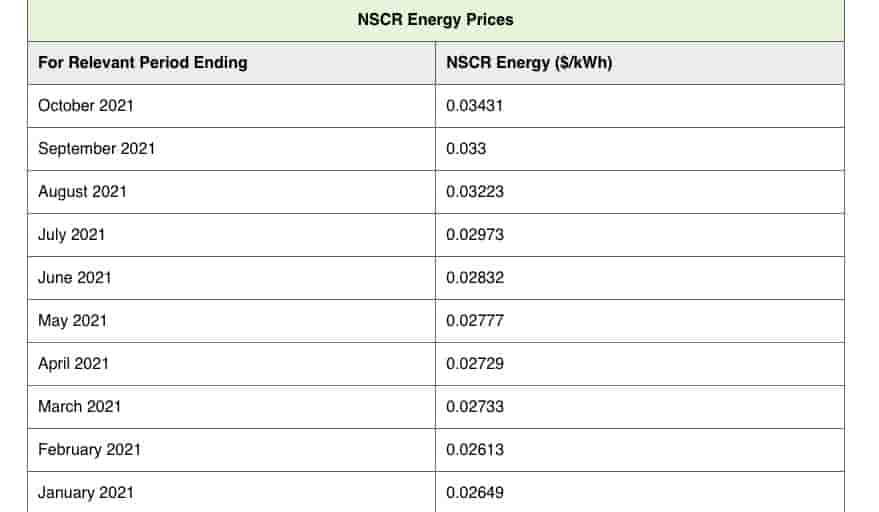
The average kWh with SCE, SDG&E, or PG&E costs ¢30. But the NSCRs are valued at wholesale electricity prices, which would be from ¢2 to ¢4. That's why they're so low.
Example: Let's say that after 12 months you have 300 kWh you didn't use. If the kWh is worth $0.30, that would be $90 of energy credits (300 kWh x $0.30 = $90).
Now, if we take the middle range of the NSCRs at ¢3, out of those $90, you would only get to carry over $9 for the next year (300 kWh x $0.03 = $9).
💭 But remember, this is ONLY applied to the excess energy at the end of every 12 months from the date your system was turned on, also called the PTO Date (Permission To Operate).
TOU stands for, "Time Of Use".
Under
Net Metering 2.0, when you go solar you will
automatically get switched over to a
TOU Rate Plan instead of the classic Tier Plan you're probably used to. That's if you were not already enrolled in one.
The
only difference with the standard Tier Plans, would be that instead of having a fixed price per kWh, its price will change according to the time of the day.
It'd be something like this:

This might have you thinking: "How does it affect me if I go solar?
Well, the problem here is that the energy also gets credited according to the time in which it was generated, and by the time Peak Hours hit and you start asking back for the excess energy you already produced during the day, it's going to cost a little more...
Example: If you generated 10 kWh from 8:00 am to 3:59 pm, they'd be worth $3 (10 kWh x $0.30 = $3). Now let's say you used them all up during peak hours.
If we did 10 kWh x $0.47 -which would be the cost per kWh during peak time- that would be $4.7 bucks of energy. It's like you had technically used $1.70 more in energy.
If this was not factored into the design of your system that's money that you're going to have to pay to the utility.
✅ However, this is NOT that big of a change and can be countered by slightly increasing the system size needed. How much is slightly? 9% on average.
Before Net Metering 2.0, these costs were canceled out by the excess energy you produced. But according to the utilities, they were not able to recuperate these costs by how their economics work.
The NBC's were instated so that homeowners with solar would also pay their share for low-income and energy efficiency programs that utilities have in collaboration with the state.
An NBC is a charge from ¢2 to ¢3 cents that gets added to every kWh you import from the grid. Or at least that's what almost everybody says because they don't truly know how these guys work...
And by the way, they're non-bypassable... -I wonder if that's where they got the name from? 🤔 -
The thing with NBC's is that they get calculated per hour and per kWh,
not only per kWh. And that's where most people get it wrong...
So let's take a look at How To Calculate NBCs:

Image taken from our friends at NorcalSolar.org
After running some numbers, we can estimate that 63% of your usage in kWh will get an NBC. But let me explain:
NBC's will
ONLY come around when at the end of any given whole hour in a day (8am, 9am, 10am, etc), your production was less than your consumption. That means you will get one NBC for every kWh consumed
beyond
your total production in that 1-hour window.
So if you are ever in doubt, pull up your calculator and plug in this highly complex mathematical operation ONLY during hours where your consumption was more than your production:

1 Hour Solar Production - 1 Hour Energy Consumption
=
Amount of kWh that will get an NBC attached to them. Like a leech.
And how would that look like in dollar numbers?
Imagine that your average energy bill was $407 before solar, just like one of the guys from our Californian Case Studies...
Not that bad huh? I bet you were thinking they would be a lot more!
I know it's still a little something, but hey, if you're already paying $291 with solar (like this guy) instead of $407, that's way better even with NBC's around!
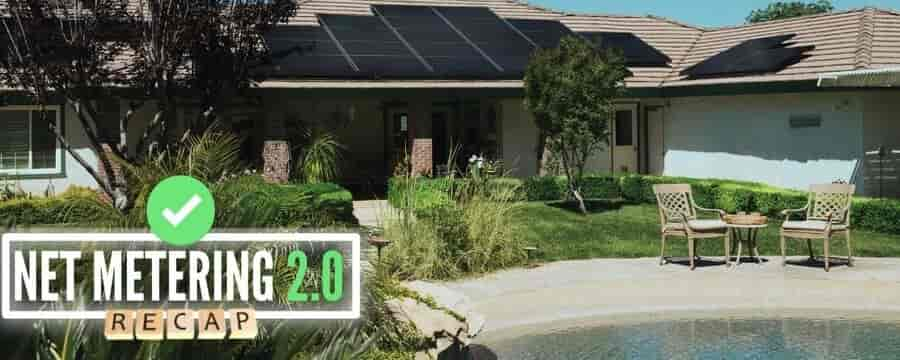
A grandfather clause in the Senate Bill protects you from having any changes done to these NEM 2.0 agreements for 20 years from the date you went solar:
✅ The Minimum Delivery Charges and the NBC's will pay for themselves with the savings from the first 3 to 4 months of the year.
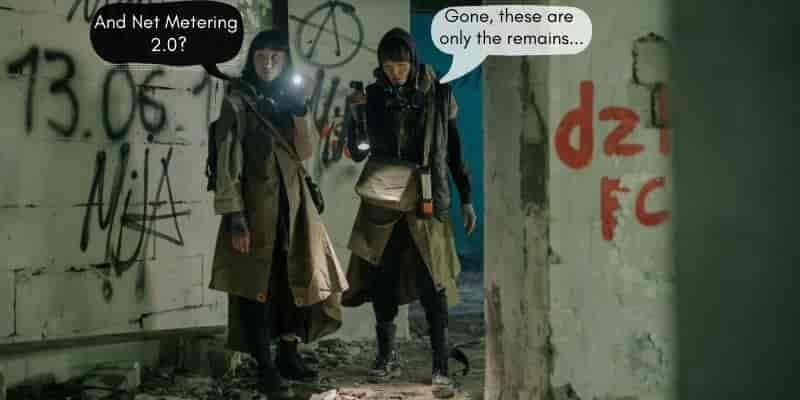
The zombie apocalypse is nothing compared to what's coming... Net Metering 3.0.
So if you've been thinking about going solar, right now it's do-or-die.
Here is why:
When version 2.0 was put up back in 2016, the CPUC decided that it was going to be revisited by 2019 to evaluate what needed to be adjusted and if solar needed fewer incentives to keep flourishing.
A golden opportunity for utilities yet again.
But wait... 2019 is more than gone! Does that mean it's over? Did I learn all this stuff for nothing?
No. To our luck, PG&E went bankrupt that year and COVID came shortly after. Therefore, they had to postpone the date on which the framework for version 3.0 would be revealed and that bought us some time.
It was supposed to be rolled out during 2019, but due to that, the final decision was pushed out to January 2022.
There has been a lot of speculation on whether January 2022 is going to be the deadline for those who want to make it into NEM 2.0, or if they are going to give a period of grace for a couple of months after they announce what NEM 3.0 is going to look like.
Word in the streets is that it might be January, based on all the recent pressure from the utilities, the union of electricians that work for them, and even some powerful allies like assembly member Lorena Gonzalez.
Who by the way, along with others, spearheaded the failed assembly bill AB 1139 with countermeasures even more radical than the ones seen in the proposals for NEM 3.0.
All to
arm-twist the CPUC into coming up with a final decision as soon as possible, in her own words.
Remember how the CPUC addressed everything that was putting stress on the grid and the shoulders of non-solar households?
Well, now utilities are saying that it was not enough and that they are still increasing the prices for those without solar. Even with all those procedures from NEM 2.0 in place.
Curiously enough, if they were really worried about people paying more, they would leave solar alone, but instead, their acts show that in reality, what worries them, is their profits.
Bold claim? Yes! Here is why I say that:
There are several studies like this one, from the CPUC themselves, stating that protecting the lines from wildfires in CA is one of the factors that are driving electricity prices up the most.
But they keep building them. Why? Because distribution & transmission is where 3/4 of the profits are at. See for yourself:

They buy the electricity at around 3 cents, remember? The rest comes from that. Simple math... increase your power lines and you shall increase your profit.
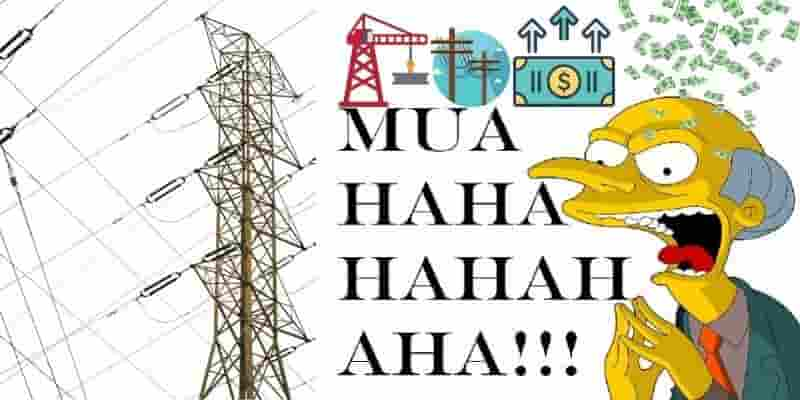
And what about this other study from a grid-planning company? With sophisticated modeling, they found that the cheapest way to grow and maintain the grid is actually through DER's (distributed energy resources) like rooftop solar.
How cheaper? 473 Billion cheaper.
And to top it off, I kid you not, even CAISO (a grid operator from CA) publicly issued a press release saying that rooftop solar changed local loads and that thanks to that, they backed out of a $2.6 Billion Investment in transmission lines.
Seeing is believing:

But even with all that out there, their claims always only mention their solar-induced problems, NEVER the ones that solar has solved for them and the avoided costs they get to enjoy thanks to us.
With that said, they're still asking for more of what they already have. And the proposals they have submitted to the CPUC as for what they expect from Net Metering 3.0 are far from pretty.
They go like this:
Remember we talked about these and that they came out to be around $12 per month?
They want to increase them. SCE is now asking for $56, PG&E is asking for $86 and SDG&E is asking for $91.
Because 12ish was not enough to keep the grid in good conditions, even with the present NEM 2.0 measures that supposedly account for that.
They are trying to cut the value of the excess energy by 75%! That would mean that the 1:1 rate we've been talking about would be 1 to 0.25. If the kWh costs ¢30, you would only be getting 7.5 cents for each kWh.
The most vital aspect of solar, taken from us. Wow!
Ok, we already have the excess energy being credited at 25% of its real value, but it gets worse.
If at the end of the month you have excess energy (which would be at least 6 months out of the 12 in a year), they will not let you carry it over for the next month. It would just go to the trash.
The thing is that energy doesn't go to the trash, it goes into their grids and they make use of it! Why would something that's coming out of your house and of your pocket, have to be given to them for free?

If that didn't blow you away, I don't know what will. But I wouldn't expect less from these guys, there's too much in play for them to just leave solar to its own.
The worst thing in all this is that the net metering agreements are designed to be revisited every few years. So from here, it can only go down.
And that's supposing that the attacks won't keep coming. But rest assured they will, because their profits come from extending the grid, even if that means raising their prices for everybody.
And the more terrain they gain, the worse it's going to get, just like we've already seen with other states.
Don't let this one pass you by.
Now is when. The boats have yet not sailed. Jump on them now and save yourself by taking advantage of the legal protection while it's still available before these guys pull out all their cards. And rest assured they will.
(If you're reading this before the end of January 2022, you can still make it into Net Metering 2.0. Remember that it takes some time to get your project city-approved and installed, so the sooner the better).
Don't wait for solar to go down the drain.
Let's get working on your project and beat the January deadline! 💪
🧠
No-Fluff Blog Posts
Let us know what you think...
